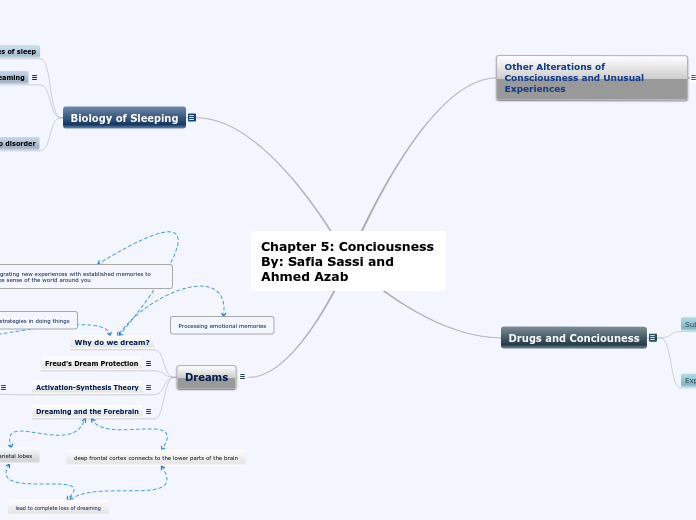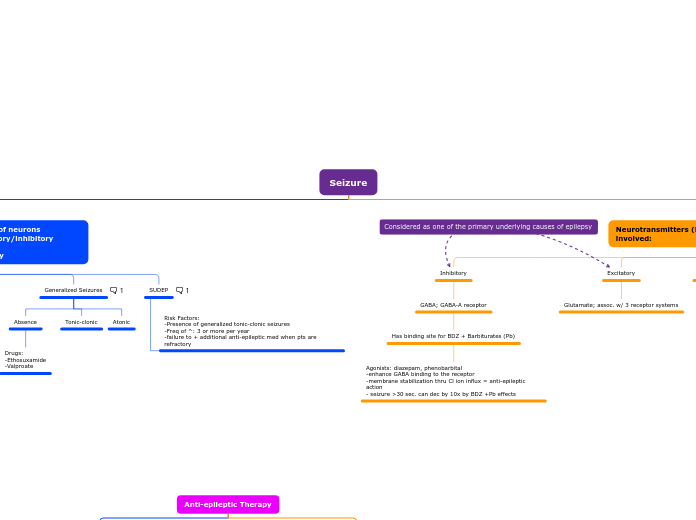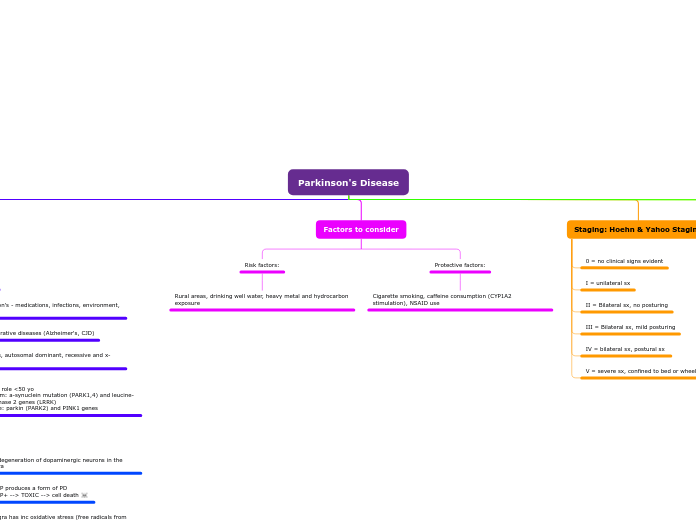Processing emotional memories
lead to complete loss of dreaming
parietal lobes
deep frontal cortex connects to the lower parts of the brain
learn new strategies in doing things
integrating new experiences with established memories to make sense of the world around you
Note: The flow of the cycle starting at 2 and following that order
Chapter 5: Conciousness
By: Safia Sassi and Ahmed Azab
Dreams
Humans tend to dream in REM stage, stage 5, but they may also dream in the other sleep cycle stages as well.
We tend to dream about dreams that hold aggression rather than friendliness.
Dreaming and the Forebrain
Since dreams are lead by motivational and emotional control centers of the forebrain as logical part if the brain.
So once the forbrain is damaged humans have a hard time dreaming as they cannot process the info sent to the forebrain.
Activation-Synthesis Theory
The balance of the neurotransmitters in the brain shifts continually during the day and night.
The acetycholine surges turn on the REM, as the neurotransmitters serotonin and norepinephrine are shut down. The acetylcholine activates nerve cells in the pons which are located at the base of the brain. They send incomplete signals to the lateral geniculate nucleus of the thalamus and relay for sensory information of the fore brain.
Hobson proposed that dreams a
Hobson proposed that the primitive or primary state of brain organization that starts to develop in the uterus, before birth is a building block of the consciousness. This idea is known as the "protoconsciousness".
Raw emotions and perceptions become dominant. While the reasoning part of ourselves shrink.
Freud's Dream Protection
Signmnud Freud agreed with the First Nations people theory which they believed that dreams revealed hidden wishes and desires.
He describes that the ego acts as a sort of a mental censor which is less able to sense sexual and aggression instincts rather than being awake.
Why do we dream?
Biology of Sleeping
Why do we sleep?
- critical role for lesrning, storing memories and remebring info
- cirtical for immune system
- some poepl say that it gives us insight in solving problem
- it is essential for brain activation sd it helps the body work on its' conciounse and ability to plan, reason and function
- growth of the body
- help the body rest and orangs to rest as well
Human spend 1/3 of their lifetime sleeping.
- 7-10 hrs is the number of hours needed
- 16+ hr needed for newbron
- University students may need up to 9 hrs of sleep
When humans are sleep deprieved many body changes are
Sleep disorder
Sleepwalking
Sleepwalkers tend to acts as if they are awake but, clumsier. People whom are sleep deprived are most likely to experience this.
Sleepwalker have the ability to walk, drive cars and turn on computers.
Night terrors
This disorder is typically harmless and usually occurs to children. But can occur to adults when when they are facing lots of stress. This causes the sleeper to have episodes of screaming or crying or confusion and wide-eyed but falls back to deep sleep once the episode is over.
Sleep Apnea
This disorder afflicts 2-20% of the population.
This disorder is caused by a blockage in the airways during sleep. This causes the sleeper to snore loudly, gasp ans sometimes stop breathing.
Narcolepsy
This is a dramatic disorder where sleepers have an episode of sudden sleep. They sleep anywhere for few seconds to a couple of minutes with no specific time nor place. The sleep could last up to an hour.
Insomnia
Most common sleep disturbance
Has multiple forms
- trouble falling asleep
- waking up too early in the morning
- waking up during the night and trouble going back to sleep
People who suffer from it tend to have depression, continual pain or variety of medical conditions.
Stress also plays a big factor. As it causes a recurrent state of frustration and anxiety affecting the body.
Lucid Dreaming
Lucid dreaming is when the dreamer is aware that they are dreaming when they are undergoing a dream. Dreamers are aware of their dream when they experience an improbable situation which makes them think and reassess their situation, concluding they are dreaming.
Lucid dreaming is related to the cerebral cortex which is connected to the self perception and evaluating thoughts and feelings.
Most of the people experience such sort of dreaming.
Hybrid between awakeness and REM sleeping
Stages of sleep
Stage 1
· Last between 5-10 min
· Produces theta waves
· The sleeper experience body jerks
· The sleeper may also experience bizarre, scrambled dream like images
Stage 2
- There are sudden bursts of electrical activity which last about 12-14 cylcle/sec are called sleep spindle
- When the waves sharply rise and fall that is known as the k-comlexes
- Appear only when we are sleeping
- § Since brain activity decelerates
- § heart rate slows down
- § muscles are relaxed
- § Body temperature cools down
- Last between
- The brain waves slow down
- 65% of our sleep
Stage 3&4
- Last 10-30 min
- Known to have delta waves
- Stage 3 hold about 20-50% of the delta waves appear then
- Stage 4 hold about 50% or more of the wave which appear
- These waves represent deep sleeping and the experience of fully rested the next day
- Children spend 40% of their sleep during thus stage
Stage 5
- Lasts around 15-30 min then returns back to stage 2
- Known as the REM sleep (rapid eye movement)
- Occupies around 20-25% of sleep
- Dreams often occur during this stage
o Dreams are mostly emotional, illogical and sudden shifts in the plot
o Can last around ½ hour to an hour
- Bodies are relaxed and not moving as if the person were to be disabled
Drugs and Conciouness
-Every culture discovered certain plants that has the potential of dramatically altering the consciousness.
-Psychoactive drugs like marijuana, tobacco, coffee beans, etc. contain chemicals like the ones naturally existing in the human brain that alter the consciousness by changing chemical processes in neurons.
-effects of drugs depend on far more than their chemical properties
-some of the factors that affect the drug effects include: beliefs and expectancies about the effects of drugs, the settings in which people take these drugs, their cultural heritage, and genetic endowment
Explanations for drug use and abuse
-There are several reasons why a person would decide to take a drug. It could because of the availability of the substance, family and peer approval, and when experimenting for fun.
-Drug use and abuse usually start in early adolescence, peaks in early adulthood, and declines sharply thereafter.
Sociocultural Influences
-Wet societies in countries like France and Italy consider drinking a healthy part of daily life.
-In a wet country like Poland, the annual rate of alcohol dependence among adults is 11.2 percent
-Unemployed societies or individuals are at relatively higher risks fir alcohol abuse and may use alcohol to cope with being out of work
Substance Use Disorder
-A person is diagnosed with Substance Use Disorder when they experience recurring distress and significant impairment with a drug
-It is a relatively new diagnostic category and is a combination of previous diagnostic categories of substance abuse, which include symptoms of tolerance and withdrawal
Psychological dependence
-psychological dependence is when people continue to take a drug because of cravings despite knowing the consequences the use of given drug negatively affects relationships
Physical dependence
-Physical dependence is when people continue to take a drug to avoid withdrawal symptoms
Withdrawal
-Withdrawal is experienced when people use drugs for too long and then cut down or completely stop using said drugs
-Withdrawal symptoms can vary depending on different factors which are: the time period over which the drug was used, the type of drug used, and the method used to stop using the drug
-For example, alcohol withdrawal symptoms can range from insomnia to mild anxiety to seizures or extreme visual hallucinations
Tolerance
-Tolerance occurs when people need to consume an increased amount of a drug to achieve intoxication. When a person abuses a drug for too long, the "kick" that comes with it is no longer is present.
-The more time people spend under influence of a certain drug, the more tolerance is developed and the weaker the influence of such drug is induced
Other Alterations of Consciousness and Unusual Experiences
-several variations on the theme of consciousness besides sleeping and walking
-examples include: hallucinations, out-of-body, near death, and déjà vu experiences
déjà vu
-feeling or reliving an experience thats new
-the idea that deja vu is a memory from a previous life is unfalsifiable and as such this explanation is outside the boundaries of science
-people who experience small seizures in their right temporal lobe usually go through deja vu right before.
Near death
-about one-quarter of patients with NDEs experience their consciousness outside their bodies
-passing through a dark tunnel, experiencing a bright light as a “being of light”
-meeting spiritual beings or long-dead relatives, all before “coming back into the body”
-Roughly 6 to 33 percent of people who’ve been close to death report NDEs
Out-of-body experience
-Experience a sense of the human consciousness leaving the body
-Can be categorized as a mixture of visual and auditory hallucinations
-Occurs to about 25 percent to college and university students and 10 percent of general population
Hallucinations
-Ranges from seeing ghost-like apparatus to scenes of splendid beauty and can seem amazingly real.
-They feel significantly real in the absence of external stimuli
-Can occur in any sensory modality
-Two types of hallucinations are visual and auditory hallucinations
-Emphasis on the link between perceptual experiences and brain activity
Visual Hallucinations
-any hallucination that occurs through visual perception
-the visual cortex is usually active during visual hallucinations
-can be brought by oxygen and sensory deprivation, epilepsy, fever, dementia, and migraine headaches
Auditory Hallucinations
-Auditory hallucinations can occur when patients mistakingly attribute their thoughts, or inner speech to an external source
-Contrary to common belief, auditory verbal hallucinations can occur to both psychotic and non-psychotic. However, auditory verbal hallucinations for psychotic people produces much more negative voices which are also less controllable.









